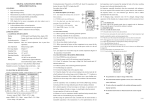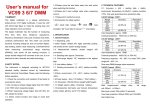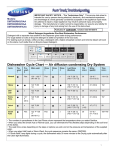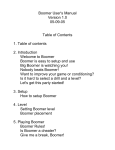Download isoPV - Bender
Transcript
isoPV Installation Bulletin / Reference Guide TM This document is intended as a reference guide for installing and using a BENDER isoPV ground fault detector and AGH-PV voltage coupler for ungrounded solar (PV) arrays. This document includes installation, setup, and usage instructions. For complete details, including installation, setup, settings, and troubleshooting, refer to the isoPV user manual, document number TGH1454en. This document is intended as a supplement and not a replacement to the complete user manual. Only qualified maintenance personnel shall operate or service this equipment. These instructions should not be viewed as sufficient for those who are not otherwise qualified to operate or service this equipment. This document is intended to provide accurate information only. No responsibility is assumed by BENDER for any consequences arising from use of this document. Installation Wiring - Multiple isoPV Devices in Arrays with a Common Bus Mounting The isoPV and AGH-PV are designed for DIN rail mounting. Only one isoPV detector at a time may be online and measuring in a complete isolated system. Arrays connected to a common bus, which may or may not be connected simultaneously, require special connections in order to ensure that only one device is on at a time. These requirements may be accomplished in one of two ways: Wiring - General See figure 1 for basic wiring schematic. Use of the AGHPV voltage coupler is required. Use minimum AWG 24, maximum AWG 12 wire. For more information, refer to the isoPV user manual. ! DANGER HAZARD OF ELECTRIC SHOCK, EXPLOSION, OR ARC FLASH • Disconnect all power before servicing. • Observe all local, state, and national codes, standards, and regulations. 2 4 3Ø AC System, W/O N 1Ø AC System Un 3 5 3Ø AC System, W/ N DC System • Option 1: Connecting each device’s F1/F2 standby terminals and manually controlling the switching with control logic Option 2: Automating the switching by connecting each device together via RS-485 • For option 1, closing the F1/F2 terminal set puts the device into standby mode. Using control logic from the tiebreaker will allow for manual control to ensure that only one device is on when the tiebreaker is closed. Option 2 automates the process. Complete the following steps: 1. Connect each isoPV in series with each other via the “A” and “B” terminals. Use RS-485 cable. 2. The devices at the beginning and the end of the chain require activating the termination resistor. Switch the “Ron” DIP switch to “ON.” 3. Each device requires a unique communication address. Under the menu option “COM SETUP > Addr.” set one device to address 1. Set the address for each other device sequentially. Each address must be unique. 4. For each device, under the menu option COM SETUP > ISONet, set this option to “ON.” This setting automates the process of ensuring only one device is measuring at any time. See the reverse side of this document for more information on menu settings. Un Solar array 1 6 1 Solar array 2 Grid transformer Figure 2 - Using the F1/F2 standby terminals with two isoPV devices and two arrays on a common bus 7 8 9 10 11 12 13 Figure 1 - isoPV and AGH-PV wiring diagram Wiring - Contacts Using a normally closed or normally open contact utilizes two factors: wiring out of the proper terminal, and setting the respective contact to normally energized or deenergized operation. Refer to the chart below for relay conditions. The energized state of the contact may be changed by setting options ISO SETUP > K1 and ISO SETUP > K2. In the device’s settings, option “N/O” refers to normally deenergized, and option “N/C” refers to normally energized. External supply voltage; 6A fuse recommended for internal device protection 7. External TEST terminal, N/O contact 8. External RESET terminal, N/O contact 2. Connection to three-phase AC system without neutral Device Relay Conditions 9. STANDBY terminals: Closing F1/F2 will stop measurements Relay Operation Setting Device Alarm State 3. Connection to three-phase AC system with neutral 10. Analog outputs: 0... 400 μA on standard version, 0/4... 20 mA on “B” version 4. Connection to single-phase AC system 11. RS-485 interface 5. Connection to DC system Normally deenergized mode (N/D) Non-failsafe mode “N/O” in device settings menu 12. Alarm relay K1: SPDT contact 6. Equipment ground connection 13. Alarm relay K2: SPDT contact 1. K1 STATE K2 STATE Power ON, normal state (no alarms) 11-12 CLOSED 11-14 OPEN 21-22 CLOSED 21-24 OPEN Energized in the alarm state Power OFF 11-12 CLOSED 11-14 OPEN 21-22 CLOSED 21-24 OPEN Relay will switch when the alarm is activated. Power ON, alarm state 11-12 OPEN 11-14 CLOSED 21-22 OPEN 21-24 CLOSED Normally energized mode (N/E) Failsafe mode “N/C” in device settings menu Power ON, normal state (no alarms) 11-12 OPEN 11-14 CLOSED 21-22 OPEN 21-24 CLOSED Energized in the normal state Power OFF 11-12 CLOSED 11-14 OPEN 21-22 CLOSED 21-24 OPEN Relay will switch when the alarm is activated, or when supply voltage to the device is lost. Power ON, alarm state 11-12 CLOSED 11-14 OPEN 21-22 CLOSED 21-24 OPEN Bender Inc. • USA: 800.356.4266 / 610.383.9200 / [email protected] • Canada: 800.243.2438 / 905.602.9990 / [email protected] • www.bender.org Document NAE1018370 • 10.2012 • © Bender Inc. • Page 1/1 • Side 1/2 isoPV Installation Bulletin / Reference Guide TM Menu Structure Flow Chart Front Panel Display Figure 5 shows the structure of the menu built into the isoPV. The menu is used for viewing alarms, viewing the status of the system, and making any necessary settings changes. Use the supplied gray boxes to take note of applied settings for future reference. Note that some settings do not have more than one selectable option - these are special options tuned specifically for PV systems. Menu or settings option Settings option essential for proper operation 1 1. EXIT 2. HISTORY INFO 3. ISO SETUP 1. Exit 2.Alarm1 200 Ω... 100 kΩ 3. Alarm2 200 Ω... 100 kΩ 4. K1 N/O-T N/C-T N/C N/O Flash 5. K2 N/O-T N/C-T N/C N/O Flash Memory on 7. M+/M- 0-20 mA 4-20 mA 7. M+/M-: Ri 28kΩ PV 3. Ce max 2000μF 4. Measure AMP3 6 7 INFO / ESC key: Displays system information / goes back a step in menu 5. LED “ALARM 1”: Illuminates when alarm 1 is active. 2. TEST / UP key: Initiates self-test / moves up in menu 6. LED “ALARM 2”: Illuminates when alarm 2 is active. 3. RESET / DOWN key: Resets device when latching mode is active / moves down in menu 7. LED “ERROR”: Illuminates when a device error has occured. 4. MENU / ENTER key: Opens the main menu / confirms changes in menu • Ensure that all menu options in red in the menu structure flow chart are set correctly. Incorrect settings may lead to improper readings. For alarm trip values, use the factory defaults when possible. • Use the following guidelines when setting the measuring principle under the ISO ADVANCED > Measure menu option: 5. Autotest 24 no 01 6. Clock 00:00 7. Date dd.mm.yy • AMP4 • Use option “AMP3” for arrays with mono- or polycrystalline solar panels • Use option “AMP4” for arrays using thin-film solar panels Options ISO SETUP > K1 and ISO SETUP > K2 refer to the energized state of the output relays K1 and K2 during operation. Refer to the section “Wiring - Contacts” on the reverse side of this document for more information. The menu options stand for: 00:00 ... 23:00 • N/C: Normally energized operation (failsafe mode) • N/O: Normally deenergized operation (nonfailsafe mode) • N/C-T: Normally energized operation, switches during self-test • N/O-T: Normally deenergized operation, switches during self-test • Flash: During alarm, contact switches app. every 2 seconds 2. Addr. 1 ... 30 Analog Outputs 3. ISONet on off 4. ISO Monitor 1 ... 30 IsoPV models feature a 0 - 20 mA or 4 - 20 mA output, selectable in the main menu under ISO SETUP > M+/M-. Under menu option ISO SETUP > M+/M-: Ri, the midpoint of the equation may be set to 28 kΩ or 120 kΩ. When using an externally connected analog meter, ensure the midpoint setting is the same as the external meter. For integrating into control systems, use the midpoint value appropriate for the system’s requirements. 1. Exit 6. PASSWORD 2. Password 000 ... 999 3. Status on off 0 - 20 mA output 1. Exit 7. LANGUAGE English Deutsch 2. Text RF I RI Insulation resistance in kΩ Current output in mA Midpoint setting RF I RI Insulation resistance in kΩ Current output in mA Midpoint setting 4 - 20 mA output 8. SERVICE Figure 5 - isoPV menu flow chart Dimensions Ordering Information Dimensions in inches (mm). 2.9” (74) 3.2” (81) Ø 0.18” (4.5) 0.2” (5) 4.4” (111) 2.4” (60) 4.1” (104) 2.8” (71) 4.4” (112.5) 4.1” (105) 5 1. Exit 5. COM SETUP 4.1” (105) 4 1. 120kΩ 2.AGH 8. Test 3 Device Setup Tips off 1. Exit 4. ISO ADVANCED 2 Ordering Information Part No. iso-PV-327 with AGH-PV iso-PV-335 with AGH-PV System Voltage 3(N)AC 0…793 V / DC 0…1100 V 3(N)AC 0…793 V / DC 0…1100 V Supply Voltage DC 19.2…72 V Ordering No. B 9106 5132W AC 88…264 / DC 77…286 V B 9106 5133W 3.6” (91) Screw mounting: Ø 0.22” (5.5) Figure 3 - isoPV dimensions in inches (mm) Figure 4 - AGH-PV dimensions in inches (mm) Technical Data Refer to isoPV series user manual (document TGH1454en) or isoPV series datasheet (document NAE1012370) for detailed technical information. Bender Inc. • USA: 800.356.4266 / 610.383.9200 / [email protected] • Canada: 800.243.2438 / 905.602.9990 / [email protected] • www.bender.org Document NAE1018370 • 10.2012 • © Bender Inc. • Page 1/1 • Side 2/2
















